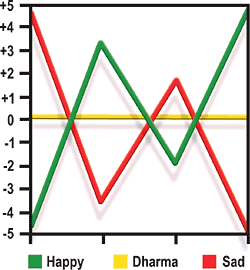 As the storm surge recedes in the media's coverage of Hurricane Katrina, one can hardly think of anything new to note on the subject, as we plough through the flotsam left behind.
As the storm surge recedes in the media's coverage of Hurricane Katrina, one can hardly think of anything new to note on the subject, as we plough through the flotsam left behind. Like many, I have been glued to the tube throughout this story, reflecting back on the many storms I've survived, mostly in the Carolinas, where year after year homes and lives were swept into the sea or flattened to the earth, only to arise again in a phoenix-like pattern.
Stock market dips to spike again, beachfront property pops up as fast as it is blown away and personal sufferings turn once again to moderated joys. So goes the cycle of our existence, from homeowner to refugee, from healthy to sick, from happy to sad and then back again.
Natural or man-made, we need not wait long on this cycle of disaster and recovery, as it happens daily: 1/9, 3/11, 9/11, 7/7 on and on, throughout our personal and collective diaries. The CNNs and BBCs thrive on this predictable pattern and the news junkie gets high or low while trying to make sense of it all.
We lead multiple consecutive cycles in a dizzy series of follow-on stories: tsunami destruction, life during tsunami, life after tsunami and then the obligatory anniversary of tsunami. Inter-dispersed between destruction, suffering caused by destruction and the recovering from destruction, is new news: the grand opening of Disneyland Hong Kong, a new Apple i-Pod the size of your jeans pocket or how jazz keeps spirits high in Singapore. Then back to the scrolling news bar on the bottom of your screen: sales are up, profits are down, gold is down and oil is up. Now we return to Katrina's waters receding in the streets of New Orleans and the tidewaters from typhoon Kanun rising in China.
Within all these ups and downs and cycles of suffering, punctuated by moments of bliss (look at that cute puppy rescued!) we try to figure out what is the constant, what is the middle ground, where is it that we, as human beings, can lead instead of just following the media around like a dog chasing its tail. What is the path through these cycles of man-made and natural disasters?
Surprisingly enough, the answer seems to be rooted in Nepal (of all places). While our small country is not exempt from any of these cycles: landslides, war, earthquakes, dips in tourism, rises in petrol prices, beauty contests...the cycles of happiness and suffering do exist.
Nevertheless, what may make Nepal unique, is that it is the spiritual epicenter of an older culture based on peace, tranquility, and the Middle Way. Most of us living in Nepal see the counter symbols of anti-extremism everyday. Whether it's a fluttering prayer flag or an ancient temple or the sound of a monk blaring a horn or the flash of a stupa as we whiz by on our way to work, the inhabitants of this kingdom, consciously or not, are bathed in another kind of daily media, the media of dharma.
Here, the cycle of the day is not rooted in anything seen on CNN. It is the cycle of life and death itself (and sometimes defined simply as the Truth). It is the cycle of the big picture, a much wider picture than we can ever purchase from our local Samsung showroom.
The Dalai Lama on Larry King summmed it up this week:
"I think it worthwhile to minimise matters of anxiety or mental suffering so that you can build your future more.if your mind is totally dominated by sadness or trauma then that will be great hindrance in rebuilding your life-your new life."
Jigme Gaton is the cartoonist behind Herojig on this paper's City page.



